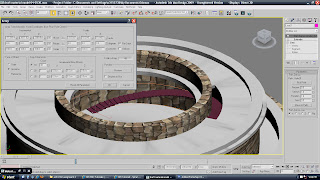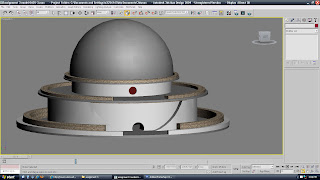
Saturday, May 30, 2009
Exporting and Texturing

Project Issues & Amendments
Here are those issues:
- Bottom slab underneath slopes need redoing as they do not match in size with the models shape - diameter
- The entrance stairs are too big. The steps are far too big for the Crysis character to travel up
- The railing on the circular platfrom are too high. Compared to the character, the railing is almost triple in height. Unabling anyone on the platfrom to view downstairs.
- Some elements such as the information boards and railings need to be broken up into smaller components because they cannot be exported successfully. Also with the information boards, they need be individual elements because they will have individual images displayed on them.
- The sun/light feature needs to be reimported. It did not work as an animation, but only as a still object. Using a recently found animation tutorial video. This should be easy to do.
- The lion statues need re-exporting. Crysis refuses to import the item as there are many degenerate faces, and multiple item errors. One solution could be, split the statue in halves by cutting it in max using boolean cut. Then reassembling the halves in Crysis.
Team Meeting
In yesterday's studio class, our group had had a meeting with Jeremy, Graham and Stephen Peter. We discussed our intentions for completing our final stages of the assignment and how our our team was progressing. During this meeting alot of design issues were debated and resulted in some design changes. Careful comparisons with the 3 images obtained by original architect Boullee allowed our tutors to outline what steps we had to take to improve our design.
Pui Pui and I began working through this issues systematically and drew up a plan on how to start. Once we pinpointed all the vital points put before us by our tutors, we proceeded to develop them in 3ds max. We worked deligently throughout the day and sorted out all the design improvements. It was about 8pm when we concluded our team meeting and broke down all the components of the model, so that the next stage of exporting it into crysis could be initiated. We plan to again meet next tuesday, where we will start the crysis fabrication.
Later that evening I stayed on in labs to work our our team blogs and also updated my own individual blog. I also managed to manufacture some other elements of the design such as the sarcophagus and the gargoyles from sketchup during this time.
Design Progression

Friday, May 29, 2009
Redesigning model in 3ds max

Project Progress
Team Meeting
Specialisations
Week 10 Studio Class
Thursday, May 21, 2009
Team Plan for Polished Fabrication
This is the new Team Fabrication Plan of Team Urbans. This plan's purpose is to further enhance our model and environment from the last assignment. Our process for development will be based upon:
- critiques from "Final Fabrication"
- implementation of explored specialisations
- defining areas we believe will polish our Crysis environments to a level of high detail, functionality and a believable level of immersion
Weaknesses
- Textures on building
- Water elements
- Lighting interior
- AI
- Model improvements
- Sun/light fixture
- Surrounding vegetation
- Interactivity
- Surrounding buildings
Collaborative Specialisations
- programming, skinning, etc.
- custom animated models (people, vehicles etc)
- advanced AI
- analysis
- cut scenes
custom materials and textures {Team Urbans – Pui Pui} - elevators, escalators etc
- on screen overlays (text, information, etc.)
- weather controls
- cutscenes, staged walkthroughs, etc.
- traffic control
- advanced sound
- custom mini map
- custom lighting interactivity
- advanced water
- advanced textures
- video (materials, web, etc.) {Team Urbans – Michael}
- custom characters (change Default, etc.) {Team Urbans – Joanne}
- advanced elevators (movers, escalators, etc.)
- advanced player movement (teleportation, flying, etc.)
- custom vegetation
- advanced environments {Team Urbans – Gordon}
Expected Level of Resolution
- Surrounding terrain reduction
- Complete environment modelling
- Add more AI
- Exterior Lighting modelling
- Interior video
- Exterior video
- Video editing
- Complete final model design
- Textures and applied materials
- Create sun/light animation
- Complete team blog
- Explore specialisations
Individual Tasks
Michael:
- Manage and organise team
- Write Team Fabrication Plan
- Work on individual specialisation
- Update, management and team blog
- Work out new design – (research, sketches, modelling in 3dsmax etc.)
- Modelling building in 3dsmax (Working with Pui Pui)
- Recreate Sun/light fixture animation in max then Crysis
- Create sarcophagus in Sketchup
- Create gargoyles in Sketchup
- Export all components of the model into Crysis
- Research relevant custom materials
- Develop textures for model inside Crysis
- Internal Lighting
- Develop Crysis surrounding buildings
- Make internal videos
- Research music for videos
- Create Information/presentation boards inside model
- Create vegetation for model
Joanne:
- Assist model improvements
- work on presentation plan
- Create and edit trailer videos
- Create and edit extended videos
Gordon:
- Finish surrounding buildings
- Get objects onto a better layer structure
- Add AI groups to streets, paths and Cenotaph
- Add traffic to roads
- Add invisible barrier to a 500m radius around our working area, delete unseen stuff outside it to reduce polys
- Fix sounds that appear to be broken
- Fix the lake
- Import more European looking trees
- Look at putting a boat on the lake
- Adding cameras and cut scenes (some at Dusk)
- Populate park with benches, get AI to sit down
- Add an underground cave leading to "the real tomb"
Pui Pui:
- Recreate model in max
- entrance stairs, pyramid stairs, interior stairs
- Reduce planter boxes
- Create slab underneath building
- Create inner half of sphere
- Pyramid stairs on first level platform
- change entrance opening (semicircle shape)
- Circular platform
- Railings for platfrom
- Entrance opening in pyramid stairs
- Display board shapes
- Split 3ds max model into individual components for exporting
Timeline and Schedule of Work Outcomes
Team Urbans has outlined a proposed timeline and scheduled tasks. Tasks are delegated to each memeber of the group and a specified timeframe for their tasks are needed for further development of the project.
By week 9:
- Recreate all components of the model inside 3ds max
- Start refining surrounding buildings
- learn how to export from 3dsmax to Crysis more efficiently
By week 10:
- Export all components of model to Crysis
- Develop landscape and terrain
- Start texturing model in Crysis
- Develop environment (roads, street signs, buildings, curbs)
By week 11:
- Model and Crysis environment complete with all textures
- Finish developing vegetation and natural environment
- Exterior lighting
- Light animation
- Create statues and sarcophagus in Sketchup
- Dome lighting and texture - for virtual sky
- Recreate river/lake
By week 12:
- Interior lighting
- Frap videos so we can make 2 videos
- Develop AI
- Develop images for information boards
- Make information boards
- Develop a presentation plan
By week 13:
- Refine all elements of Crysis environment
- Start editing trailer video
- Create extended video
- Capture 10 stunning images
- Complete team blog
Team Urbans Meeting with Class Tutors
Areas of improvement for Team Fabrication
Final Presentations
Thursday, May 7, 2009
Assignment 2 - Final Fabrication
The Cenotaph, designed by Etienne-Louis Boullée has greatly influenced contemporary architects; he was a visionary French Neoclassicism designer, and so it is important to consider his intent in creating the Cenotaph. This design explores geometric forms that are used at such a scale, that the architectural boundaries are pushed to stamp a bold statement. Each element that is used in the design, help explore the importance of the environment it’s placed in. The Cenotaph’s purpose and intent is complimented by an array of simple elements, such as the importance of strategically placed trees counter parted with layered tiers, and the significance of texture and curvature. All ingredients that suggest a form of elegance and classism. Boullée promoted the idea of making architecture expressive of its purpose. The elements and techniques that the Cenotaph employs are dedicated to the English scientist Isaac Newton. Memorialising his work as a physicist and also immortalising his life and influence in life, in space.
The Cenotaph that has been re-created in Crysis explores a degree of movement of two worlds. A classic style building situated inside of a natural environment, that being Regents park London. The second being our virtual interior solar system.
Our intent was to contrast these two aspects of the design and hence create an impact. The initial impact, when one walks in view of the Cenotaph and appreciates the sheer size of the building in a natural setting and then, again as they enter the confines of the building. A captured virtual night sky/solar system. The building fully expresses itself in the daytime as one walks through the familiar park lands in sunlight, then dramatically enters a mystifying world of stars, comets and an illuminating sun globe. The atmosphere articulated through the internal space, outlines the buildings performance to create an interactive experience. The dome and sphere is a main focal point both as an exterior and interior element. The roofs punched holes allow for the sunlight to shine beams of light and reconstruct stars above you, immersing the public in this unrealistic world in such a normal setting.
The Cenotaph is placed in a milieu of significance, memorialising the fact that Isaac Newton himself is buried in London. Regents Park takes on a persona that helps to provoke a feeling of belonging and monumental importance in providing the utmost appropriate environment for this design. The site is boarded by London itself. A skyline of the city can be seen from the Cenotaph. The cityscape encroaches into the park and the Cenotaph’s position in the heart of the park and also the heart of the city encourages for the building to paint a significant influence as an architectural piece.The trees that are placed surrounding the building help to create a reference point for people to appreciate the impact and scale of the Cenotaph.
The natural vegetation of the site also form a sensation of peace and tranquillity that helps prepares people as they walk into the design. Inviting the public to explore the night experience inside.
The textures and form produces a design that unites classism with sophistication. The textures that were used are considered to be weathered natural materials with earthy tones providing a realism of the building once coming from the Earth.
Up until now Boullee’s vision has forever been left unrealised, leaving this pivitol work in the imagination of all those who admire it. Here we have tried, at least in part, to realise this building virtually in a contemporary context so that it might finally have a life in the virtual world if currently it is still practically impossible to realise physically.
Final Crysis Environment:

















































